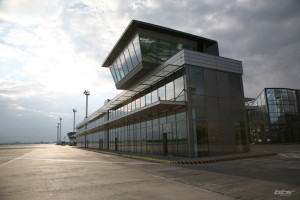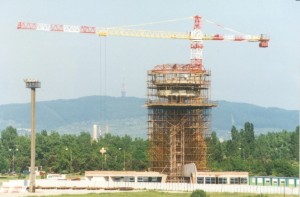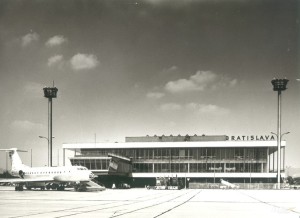History of Bratislava Airport
 The beginnings of regular air traffic in Bratislava and its surroundings date back to the first Czechoslovak Airlines flight from Prague to Bratislava on October 29, 1923 when a biplane AERO A-14 landed in Vajnory with a single passenger on board. Even back then in the postwar period it was quite clear that the proximity of the Small Carpathians mountain range will restrict the development of air traffic in Vajnory Airport and the construction of the largest Slovak airport thus began to take place in the vicinity of the village of Ivanka pri Dunaji in 1946.
The beginnings of regular air traffic in Bratislava and its surroundings date back to the first Czechoslovak Airlines flight from Prague to Bratislava on October 29, 1923 when a biplane AERO A-14 landed in Vajnory with a single passenger on board. Even back then in the postwar period it was quite clear that the proximity of the Small Carpathians mountain range will restrict the development of air traffic in Vajnory Airport and the construction of the largest Slovak airport thus began to take place in the vicinity of the village of Ivanka pri Dunaji in 1946.
This was the very beginning of the history of the current Letisko M. R. Štefánika – Airport Bratislava.
The First Phase of the airport construction began with the construction of the 04 – 22 runway and the 13 -31 runway perpendicular to it, which are still in use for the landing of aircraft in Bratislava almost in any weather conditions. Regular air traffic operations at the new Bratislava airport, which lies only 9 km northeast from the centre of the capital, were launched as early as in 1951. The rapidly changing aircraft fleet, the rising expectations in passenger and goods transportation, as well as expectations with regard to ground operations services – all of these required constant investment. The current departure terminal, together with the foregrounds and a new road system, was built over the next 20 years, as part of the Second Phase of the airport construction, together with a central boiler room and a supplementary energy facility to the main transformer station. At the same time, the apron was extended and the original airport terminal served as premises for the needs of the Ministry of Interior Squadron. In the Eighties, the runway system underwent a complex reconstruction and runway 04-22 was extended to 2 900 metres (from the original 1 900 metres) and runway 13-31 to 3 190 metres (from the original 1 500 metres). In the Nineties, the aim of the Third Phase of the airport development was to vertically separate the flow of passengers at Arrivals and Departures, which lead to the con – struction of a terminal for arriving passengers in 1994.
Airport development continued over the subsequent years. In 1995, a new modern fire rescue station was built at the intersection of the runways, which ensured the upgrade of Airport Bratislava from category 6 to category 7, facilitating the land – ing of large-capacity aircraft. Two years later, the reconstruction of the lighting and signalling system at runway 13 -31 was finalised and the airport obtained new aviation fuel storage facilities, as well as the rail – way section leading to Podunajské Biskupice railway station. In 1998, the new air traffic control tower was opened, which presently belongs to LPS SR, š.p.
An important milestone in the history of the airport was the transformation of the contributory organisation – Slovak Airport Management to a joint-stock company called Letisko M.R. Štefánika – Airport Bratislava (BTS) on May 5, 2004. The same year saw the completion of the phytosanitary centre. After Slovakia joined the European Union, the Airport began to fulfil the criteria associated with its inclusion in the Schengen air space. Amongst the first was the requirement of separating the security control for airline crews and business travellers, which was carried out in the new premises of the General Aviation Terminal (G.A.T.). An important investment was the construction of the annex to the arrivals hall – Terminal C, which is currently in sole use for passengers not requiring an entry passport control.
Another important moment in the airport’s history was September 2006, when the Slovak government announced its withdrawal from the privatisation agreement with TwoOne consortium as a result of the failure to comply with the privatisation conditions.
In 2007 and 2008, the preparations for Airport Bratislava to join the Schengen air space were peaking. The most significant changes were the creation of space for the Police Force patrol in the Arrivals terminal B, the creation of security control for transiting passengers and the relocation of the belt counters to a new location between the Departures terminals. The Departures terminal was divided into two parts: Section A, which since the official entry of the Airport to the Schengen zone has been serving passengers flying to Schengen countries without the need for a passport control, and into Section B for passengers flying outside the Schengen zone. The overall look of the passenger terminal building from the service side was altered with extended boarding gates installed in 2007. The process of the Airport’s entry into the Schengen air space was completed in 2008.
The main project in 2009 and 2010 was the construction of the new terminal, which is expected to be completed in June 2012. It represents the most significant project for the Slovak civil aviation sector in the past few decades in terms of strategy, capacity and investment. Since the beginning, the construction was divided into two phases and has been executed under full operations at the airport. The first phase was represented by the construction of a Departures terminal, which was completed after 16 months of intensive work and the terminal building was ceremoniously launched into operation on June 9, 2010. The end of the year saw the gradual demolition of the original departures terminal and the second part of the new terminal building is expected to be standing in its place within the next 2 years.
Publishing or copying the content of AVIATION Times without a written electronic permission is strictly forbidden. If you have any information, tips, videos, photos or your press releases for us contact us at news@aviation-times.aero.
AVIATION TIMES © Copyright 2012 - 2025











